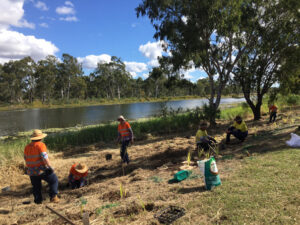
Bringing Nature Back: Yeppen Lagoon – Riparian Restoration Projects, Rockhampton Botanic Garden
By Stuart Elder
Yeppen Yeppen (now known as the Yeppen Lagoon) is located at the gateway to Rockhampton City, Central Queensland on Darumbal Country. Situated on the Fitzroy River floodplain, the Lagoon links directly to the Great Barrier Reef catchment. Recognised as Rockhampton’s first town water supply in 1861, the Lagoon continues to play a key role in our community today, providing a picturesque backdrop for a popular walking, running, cycling, fishing and birdwatching area.
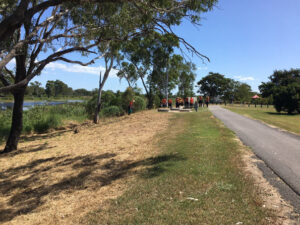
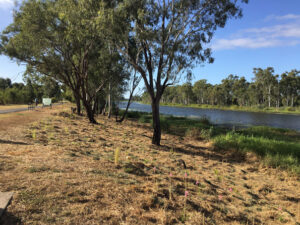
The greater than 10ha project site is located on Council land adjacent to the Rockhampton Botanic Gardens and Zoo, an important local landmark that is recognised on the State Heritage List. Known for its impressive plant and zoological collection, the Botanic Gardens receive over 300,000 visitors each year. Rockhampton Botanic Gardens (RBG) is one of the oldest and most significant Botanic Gardens in Queensland, having been proclaimed as a Reserve for Botanic Gardens in 1869. The Gardens’ first curator, Scott Edgar was appointed in 1873, and the garden was constructed between 1873 and the 1930s and celebrated its 150th Anniversary in December 2019. The Gardens were added to the Queensland Heritage Register on 23 July 1999.
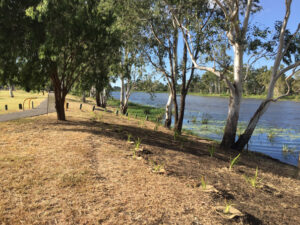
Yeppen Lagoon is a popular biodiversity hotspot that plays a vital role in supporting a healthy catchment and liveable community. The Yeppen is a palustrine freshwater wetland and up until the project began, was void of vegetation along the riparian sections of the Lagoon with very little native groundcover existing on the site. A large proportion of the site was underutilised grass areas, which required ongoing mowing and maintenance on a sloping site. A number of environmental weeds existed in this area such as Green Panic (Panicum maximum var. trichoglume), Guinea Grass (Megathyrsus maximus), Indian Couch (Bothriochloa pertusa), Para Grass (Urochloa mutica), and Lippia (Phyla canescens, also known as Condamine Couch). Lippia is a weed that is well adapted to floodplains and adjacent areas and is extremely difficult to control.
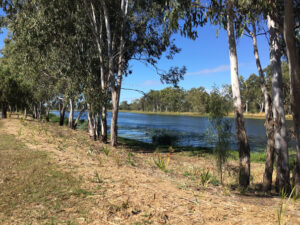
The project has significant ecological benefits to the restoration of riparian buffers in this Queensland State Significant wetland, and its biodiversity status is “sub-dominant ‘of concern’ remnant vegetation, eucalypt woodlands to open forests on floodplains and wetlands.”
Native tree species present are typical of the local floodplain, with soils of a fine alluvial floodplain clay. Endemic species include Eucalyptus tereticornis, Eucalyptus coolabah, Eremophila bignoniiflora, Melaleuca dealbata,and Acacia salicina.
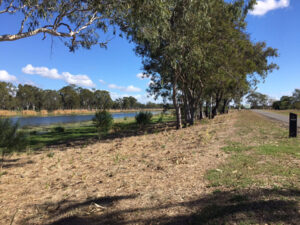
The crucial piece of the puzzle though, was the sustainability team securing funding through the Queensland State Government – Skilling Queenslanders for Work (SQW) program. The Council has partnered with two groups that work concurrently, Multicultural Australia and Capricorn Catchments, in supporting this Skilling Queenslanders for Work project on site, and delivering the on-ground restoration works. As part of the program, participants, within groups of up to fifteen people, study in Cert 1 Conservation and Land Management.
The Yeppen Lagoon floods when there’s significant rainfall. It is connected to the Murray Lagoon and floodwater meets up with the Gavial Creek system before entering the Fitzroy River further downstream.
The first steps of the project began in early 2022 when we appointed our first dedicated employee for Rockhampton Regional Council for on-ground Natural Resource Management (NRM) practices. This was in the position of Project officer – Natural Areas and Community Programs, RRC staff member Kelvin Wykes, who has a vast amount of experience in Natural Areas and Nursery management, and is leading these programs on the ground plus many others across the Rockhampton region.
Following this, a detailed survey of the area was commissioned to assess the existing and appropriate vegetation community, and to formulate the appropriate species to plant. Our small but powerful Sustainability Team, expertly led by Christine Bell, Coordinator Environmental Sustainability, has been instrumental in facilitating these on-ground Natural Resource Management and restoration work programs through project scoping and collaboration with Kelvin Wykes and key NRM partners.
So far, 3000 native plants grown on from Council’s nursery team have been put into the ground on site, with a focus also on weed identification and removal techniques, herbicide application, whipper snipping, watering, installation of jute matting and mulching, as part of their learning and project delivery on site.
With the current success of these current projects, we are very excited at what the future holds for Natural Areas within Rockhampton Regional Council as we can successfully demonstrate the true value of NRM and community partnerships to protect, maintain and enhance our region.
Stuart Elder
Curator, Rockhampton Botanic Gardens & Kershaw Gardens
Rockhampton Regional Council
T: (07) 4936 8064
E: stuart.elder@rrc.qld.gov.au W: www.rrc.qld.gov.au
All images supplied by Rockhampton Botanic Gardens
Main image: Capricorn catchments group discussing planting techniques
